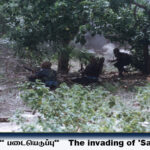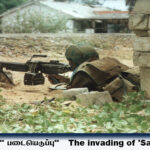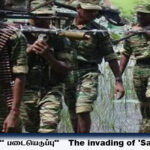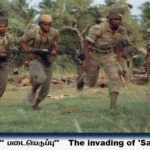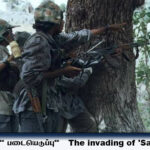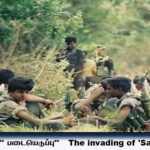

The invading of ‘Satjaya’ and the counter attack by LTTE
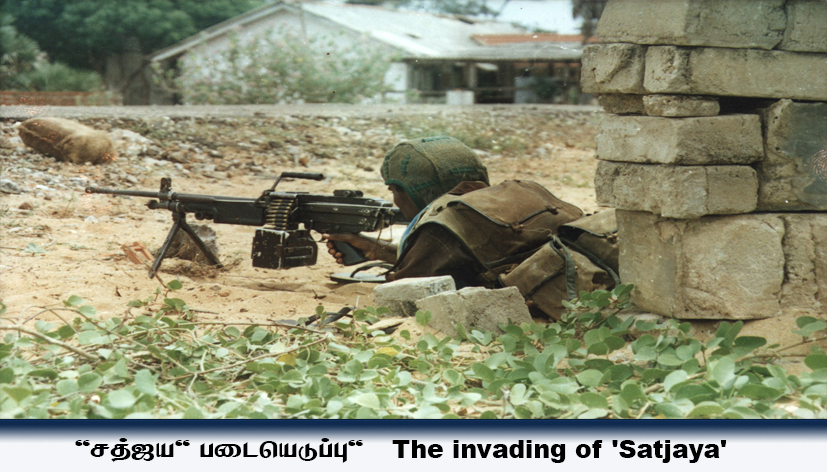
The Sinhalese have opened the main arena for the Vanni invasion from the Elephant Pass Operation ‘Satjaya’ was hastily launched by the Sri Lankan Force because of the LTTE´s enormous victory at Mullaitheevu and to make up for the humiliating defeat that had been inflicted on them. Now the Sinhala leadership has given it the shape of the final chapter of the war against the LTTE. The ‘Satjaya’ invasion, which was moved in three phases over 70 days, advanced 12km and captured Kilinochchi. The operation is now paused to prepare for the next move. The first phase of the ‘Satjaya’ activities started on July 26th.
Early in the morning, the Sri Lankan forces started their advance towards Paranthan from the Uppulam region in the Elephant Pass. The Sri Lankan forces tried to break through the LTTE line by moving toward near the main road and railway line. But this defense failed. Alternatively, they attempt to advance through Thathuvankotty, 2 km east of the main road. And this defense made it possible for them.
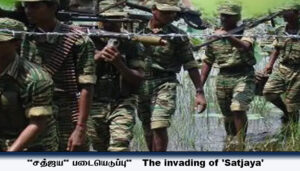 Since it is impossible to outflank a the big advancing army with very few regiments and the a counter-attack here will lead to big disaster, the LTTE had to make a tactical retreat. By the end of the day, the Sri Lankan forces advanced easily due to the fact that the LTTE had engaged in less intense fighting against them. And the Sri Lankan forces was able to advance 6 km and capture Paranthan and it was also able to be in the main road 1 km west and 2 km east. The government reported out that 16 of its troops were killed in the battle of the day. 16 of our freedom fighters became maveerar.
Since it is impossible to outflank a the big advancing army with very few regiments and the a counter-attack here will lead to big disaster, the LTTE had to make a tactical retreat. By the end of the day, the Sri Lankan forces advanced easily due to the fact that the LTTE had engaged in less intense fighting against them. And the Sri Lankan forces was able to advance 6 km and capture Paranthan and it was also able to be in the main road 1 km west and 2 km east. The government reported out that 16 of its troops were killed in the battle of the day. 16 of our freedom fighters became maveerar.
Over the next eight days 5 more freedom fighters were became maaveer in the battle with the enemy who strengthened their defenses in the newly captured territory. Ninth day – On the 4th of August the enemy started the 2nd phase of the operation ‘Satjaya’. The 2nd phase of “Satjaya” was launched by the Sri Lankan leadership. It miscalculated the LTTE’s strength, considering that the LTTE in Mullaitheevu was greatly weakened by the easy capture of Paranthan, and campaigned for the final move towards Kilinochchi.The battle was opened with “Special Forces” under the leadership of Major General Janeka Perera.The battle that broke out was unusual when Sri Lankan troops, marching into the city from Paranthan, suddenly were encountered by the LTTE.
The enemy tried to advance with multiple fronts as far as they could to break the ramparts of the LTTE. As the they lost the battle from one side, they again tried to move forward by another side. From morning to night – the entire day – the Paranthan region had become a huge battlefield. The LTTE intercepted the advance of the Sri Lankan troops on the east side of the main road on two fronts. Two tanks were struck and one was damaged. At the same time, those advancing towards the west side of the main road were blocked both the right and left sides of Poonakari Road. Field reports confirmed that 75 soldiers were killed in the first day’s battle alone. And up to 75 more soldiers were killed in the three consecutive days of the battle. In this battle, 89 of our freedom fighters became maveerar. In the following days, until the third phase of ‘Satjaya’ began, another 11 freedom fighters became maveerar in the battle of the front areas.
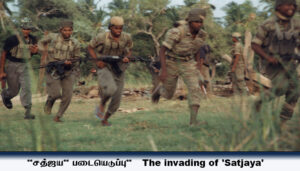 The LTTE’s victory in the second phase of ‘Satjaya’ stunned the enemy commanders.They wondered why they was unable to win even though they deployed the Air Force like never before in the Jaffna battle and gathered much more resources.The LTTE´s heavy use of force caused them more damage. And the LTTE must also have suffered heavy casualties when the Sri Lankan forces used more force than them. There is also a possibility that the LTTE’s manpower might have already been greatly weakened in the batlle of Mullaitheevu. Then how could the LTTE be so strong? Why could the Sri Lankan troops not win even though they attacked more fiercely than ‘Rivisara’?
The LTTE’s victory in the second phase of ‘Satjaya’ stunned the enemy commanders.They wondered why they was unable to win even though they deployed the Air Force like never before in the Jaffna battle and gathered much more resources.The LTTE´s heavy use of force caused them more damage. And the LTTE must also have suffered heavy casualties when the Sri Lankan forces used more force than them. There is also a possibility that the LTTE’s manpower might have already been greatly weakened in the batlle of Mullaitheevu. Then how could the LTTE be so strong? Why could the Sri Lankan troops not win even though they attacked more fiercely than ‘Rivisara’?
Seeking answers to these questions, the Sri Lankan military leadership had to make a complete change in its military plan for the Kilinochchi invasion because of the weapons the LTTE had acquired from the Mullaitheevu base and other ways. And the Sri Lankan military also realized that their traditional warfare in the Tamil Eelam War, was becoming problematic.For a month and half the Sri Lankan military planed to upright the third phase of operation ‘Satjaya’, which had slipped in the second phase. From the lessons learned in the Paranthan battles, they planned new tactics for the next move.
The enemy had to find a way to reach Kilinochchi without getting caught in the ‘death traps’ in Paranthan area set by of the LTTE.
The second phase of ‘Satjaya’ was busted within those strategies.Even though they tried hard with heavy ressources they could not broke through the borders. Even though The Sinhalese Air Force approached the LTTE with ‘Kibir’ jets, ‘Bukhara’, ‘Sia Maserati’ and ‘MJ-24’, they could not move forward in any way. Artillery shells and 120mm motors.They also tried with small motors and rockets used by specialized commandos, and moved along from multiple fronts at once, their tactic did not work.
So – without trying out more tactic again to get into the “destruction zone” – the enemy decided to move the force in a circular from 15 km long to capture Kilinochchi, which was 5 km from the Paranthan area. The enemy also had other advantages by ths tactic.
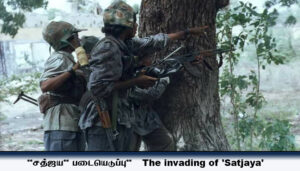 By moving in an orbit and spreading the war over many kilometers – instead of being concentrated in a few centers – the LTTE’s concentration will be in many ways, and this will probably make the LTTE to exert a less intense counter-effect. Also – The enemy also calculated that the LTTE could be brought out from the safe battle zones, and that they could fight in the new unfortified areas. And by that way they enemy can inflict casualties comparable to Mullaitheevu Battle. The enemy had to option to make such a circuitous route. The first is to move on the eastern side through the area bordering the Kanagarayan river through Murasumoddai and reach Kilinochchi via Tiruvaiyar river.
By moving in an orbit and spreading the war over many kilometers – instead of being concentrated in a few centers – the LTTE’s concentration will be in many ways, and this will probably make the LTTE to exert a less intense counter-effect. Also – The enemy also calculated that the LTTE could be brought out from the safe battle zones, and that they could fight in the new unfortified areas. And by that way they enemy can inflict casualties comparable to Mullaitheevu Battle. The enemy had to option to make such a circuitous route. The first is to move on the eastern side through the area bordering the Kanagarayan river through Murasumoddai and reach Kilinochchi via Tiruvaiyar river.
The second is to move on the western side through Kunjupparanthan area through the area bordering Uruthirapuram-Jayantinagar area and reach Kilinochchi via Dippo road.The enemy comlpleted the operation in the second of these ways. But they made the first move in the first way.The third phase of “Satjaya” started on the 22nd of September. Earlier –The second phase of “Satjaya” started with more resources than ‘Rivirasa’. Now – Phase three has started with more resources than phase two and with smart tactics to move in orbit and kill the LTTE in combat. Under the main advisor Major General Cyrilal Weerasuriya, Brigadier Vasantha Perera led the field. In Paranthan area – Jaffna.Along to the road – East. 2 km from their positions, and 1 km north of Mullaitheevu road, the Sinhalese troops were trying to move towards the Murasumoddai area to the north of the 2nd Fort, but was stopped by the LTTE in a fierce counter-attack.
Again the next day – the soldiers who continued to move in the same direction were intercepted and putted up in a counter-fight by the LTTE, who were stationed between the 3rd Fort and Murasumoddai Pond. After two days of heavy fighting in the eastern direction, on the second day at midnight, the enemy suddenly made a night movement in the western direction. The enemy also retreated from the positions he had advanced in the Murasumoddai region for the first two days.There are three reasons for not to move forward from or non-advancement of Murasumoddai. One – the route was an open field with no hidden places.
Two – it was carried out as a tactical move to distract the LTTE. Three – The LTTE put up a tough fight.The enemy who retreated from one of these reasons – made the actual move during the night. Jaffna. Enemy troops who moved from their western front positions about one kilometer along to the road about 2 kilometers north of Poonakari Road – Moving northward to Kumarapuram and Periyaparanthan areas, and through Kunjuparanthan and reached Uruthirapuram territory.
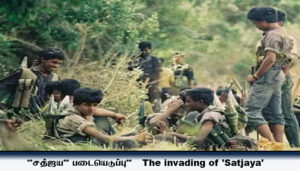 That night the LTTE were forced to retreat as a non-serious fight against the movement. Except to delay the enemy as much as possible, it is not a favorable field for a complete counter-fight. Intercepting the advancing army movement who used much more ammunition is an impossible task for the LTTE with limited weapon resources. Observing, scouting, target fighting, and sparing weapon resources were only possible in daylight battles. At night, it is only possible if they have clear information about the positions and movements of the enemy. Where does he come? What does he do? How does he move? Confronting troops moving in the dark and</ whose strategy is unknown, can be a field of destruction.
That night the LTTE were forced to retreat as a non-serious fight against the movement. Except to delay the enemy as much as possible, it is not a favorable field for a complete counter-fight. Intercepting the advancing army movement who used much more ammunition is an impossible task for the LTTE with limited weapon resources. Observing, scouting, target fighting, and sparing weapon resources were only possible in daylight battles. At night, it is only possible if they have clear information about the positions and movements of the enemy. Where does he come? What does he do? How does he move? Confronting troops moving in the dark and</ whose strategy is unknown, can be a field of destruction.
During that night’s action, the troops were moved 6 kilometers in a westerly direction and took a daybreak positioned near the Uruthirapuram Kattukulam. The enemy expected that the LTTE, who had fought fiercely in the second phase of the invasion, would carry out the same kind of fight in the third phase as well. Not only in a heavily protected area for fighting, but even if the battlefield is shifted to an unarmored are that is not prepared for fighting, the same type of fighting will be carried out fiercely.
The enemy believed in and wanted it to happen. Then – the enemy planned to inflict massive casualties on the LTTE who gave them a stupid face in the area where he had no chance. ‘Don’t do what the enemy wants you to do’ is a warfare admonition. The LTTEs also did not take that unwise decision which the enemy wanted. The generals who were leading the battlefield were Banu and Theepan.They made a change in the field according to the advice of the leader who was giving immediate instructions according to the changing field conditions. The LTTE withdrew, not being drawn into the battleground that was deliberately lured into their destruction. Such disengagement is essential for a guerilla movement like the LTTE, which is short on manpower and resources – and needs to conserve its resources.
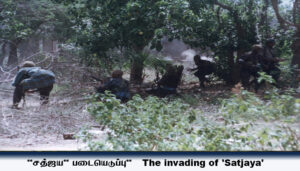 The LTTE also immediately changed their tactics of warfare in accordance with the enemy’s tactical warfare moves. Instead of intercepting and fighting the enemy – Allowing him to move forward with a limited fight – The LTTE switched to a mode of warfare that inflicted losses on the enemy by carrying out incursions in ‘favorable’ field conditions. The sophisticated plan to kill the LTTE in a fight is not only foolhardy but counter-intuitive. The Sinhalese army was also the target of an unprecedented counterattack in its history. On the night of the 2nd day, the soldiers who had moved up to Uruthirapuram Katkukulam, on the morning of the 3rd day, from there they progressed towards the 8th gate – The LTTE launched a small surprise infiltration attack within the movement of the leading assault division of the troops.
The LTTE also immediately changed their tactics of warfare in accordance with the enemy’s tactical warfare moves. Instead of intercepting and fighting the enemy – Allowing him to move forward with a limited fight – The LTTE switched to a mode of warfare that inflicted losses on the enemy by carrying out incursions in ‘favorable’ field conditions. The sophisticated plan to kill the LTTE in a fight is not only foolhardy but counter-intuitive. The Sinhalese army was also the target of an unprecedented counterattack in its history. On the night of the 2nd day, the soldiers who had moved up to Uruthirapuram Katkukulam, on the morning of the 3rd day, from there they progressed towards the 8th gate – The LTTE launched a small surprise infiltration attack within the movement of the leading assault division of the troops.
They damaged 2 or 3 battle ‘tanks’ and captured 12 rifles including GPMGs and LMGs. After this battle the enemy, who had remained silent for the next day and made no further movement—was preparing to move by another fresh route the following day. Day 5 – Thursday 26th – ‘Satjaya’ turned out to be a disastrous day for the troops. It was on that day that they faced that devastating attack. The LTTE penetrated from three fronts into the front line of the ‘Satjaya’ troops stationed near the Uruthirapuram St. Fatima College and dealt a death blow to the enemy. They dispersed the special ‘Commando’ forces stationed at those advanced positions. The LTTE carried out the fierce attack for 3 hours from 5.30 am. Air Force fighters, artillery, battle ranks and heavy artilleries – the LTTE successfully completed the attack and left the field after defeating the enemy’s best efforts to repulse the attack.
At least 200 Sinhalese soldiers are confirmed to have been killed in the attack. Sunday Times said in its issue of 29.09.96 that 190 soldiers were killed and Midweek Mirror in its issue of 16.10.96 that 206 soldiers were killed. The LTTE seized 32 weapons. 42 LTTE fighters fell on that battle.Karumpulikal team did not participate in the attack. But the Sinhalese government made false propaganda that it had repulsed the attack and that 450 LTTE fighters, including Karmpulikal, had been killed, and that it had recovered 136 corpses of LTTE fighters. However, the truth is that during this attack, the bodies of 17 of our maveerar´s body were lost in the field and could not be recovered.Through the International Red Cross the government has announced to hand over the bodies of up to 100 LTTE fighters found in fields and roadsides after the attack. Even after waiting to receive the bodies of our maveerar, the government did not provide the bodies.
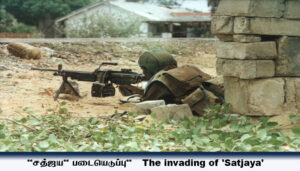 Day 6 – While the main focus of the fight and the LTTE fighters were stationed in the Uruthirapuram area – Suddenly, in the early hours of the morning, the enemy, who were about to move along the west of the main road, from the Paranthan front positions towards Karatippoku Junction – The LTTE launched a fierce counter-attack from their fortified positions and gave them suffering heavy losses. Day 7 – Again from the Urruthrapura area, the LTTE launched an attack near Kurukulam on the troops moving through Jayantinagar. A battle ‘tank’ was completely destroyed. Day 8 – When one team moved from Kurukula area via Thirunagar and another from Parathan towards Kilinochchi – The team that moved through Thirunagar reached Kilinochchi Hospital and the team that moved from Paranthan reached Karadippokku St. Teresa’s College. 2 Rivals were captured in these fights. Day 9 – Final Day of ‘Satjaya’ Phase 3 – On 30th March, the team moved south from Jayantinagar area, took Ambalkulam Junction and reached the main road via Depo Road. Phase 3 of the “Satjaya” invasion is over. Now – Sinhalese forces are stationed on a 3 km wide stretch of main road from Anaiyiravu site to Kilinochchi Central College.269 of its soldiers were killed in the ‘Satjaya’ 3rd phase, Sri Lankan Defence Secretariat says.
Day 6 – While the main focus of the fight and the LTTE fighters were stationed in the Uruthirapuram area – Suddenly, in the early hours of the morning, the enemy, who were about to move along the west of the main road, from the Paranthan front positions towards Karatippoku Junction – The LTTE launched a fierce counter-attack from their fortified positions and gave them suffering heavy losses. Day 7 – Again from the Urruthrapura area, the LTTE launched an attack near Kurukulam on the troops moving through Jayantinagar. A battle ‘tank’ was completely destroyed. Day 8 – When one team moved from Kurukula area via Thirunagar and another from Parathan towards Kilinochchi – The team that moved through Thirunagar reached Kilinochchi Hospital and the team that moved from Paranthan reached Karadippokku St. Teresa’s College. 2 Rivals were captured in these fights. Day 9 – Final Day of ‘Satjaya’ Phase 3 – On 30th March, the team moved south from Jayantinagar area, took Ambalkulam Junction and reached the main road via Depo Road. Phase 3 of the “Satjaya” invasion is over. Now – Sinhalese forces are stationed on a 3 km wide stretch of main road from Anaiyiravu site to Kilinochchi Central College.269 of its soldiers were killed in the ‘Satjaya’ 3rd phase, Sri Lankan Defence Secretariat says.
However, reports from the field confirm that no less than 500 soldiers were killed. The government revealed the amount of soldiers killed in ‘Satjaya’ by half. Mr. Ranil Wickramasingha said in a committee meeting of Parliamentarians of National Party, ‘300 dead bodies of soldiers arrived in Colombo district alone. I don’t know how many have come to other districts’ said Colombo district member Alhaj MH. It is worth ere whhat Mohammad said in the parliament speech. 133 of our fighters lost their lives in the 3rd phase of ‘Satjaya’. The warfare dimension of the Kilinochchci Battle is different; out of the ordinary; revealing a new phase of the Tamil Eelam war. For the first time in its war history, the LTTE has successfully managed a traditional battle. Comparatively – the battle against ‘Satjaya’ invasion is more progressive than the battle against ‘Rivirasa’ invasion. The experiences gained in previous wars and the new weapons that the LTTE have brought into the field play a role in this development. The introduction of 120mm motor and unnamed firearms into the hands of the LTTE made conventional warfare problematic for the enemy for the first time and provided the LTTE with the beginnings of combat capability that conventional warfare could not match.
Phase 2 and Phase 3 of ‘Satjaya’ show two different dimensions of the LTTE struggle. The 2nd phase of the battle is proof that if you are determined to hold on to your land and are ready to pay any price for it, you can completely stop and defeat an invasion.
A tactical retreat had to be made to conserve manpower. But for that, the 3rd phase of ‘Satjaya’ is proof that even if you have to temporarily lose – give up the ground, you can face an invasion and strike and inflict maximum destruction on the enemy with minimal damage. The Mullaitheevu attack is a symbol of the level of development achieved by the LTTE in guerrilla warfare. Kilinochich attack is a symbol of the LTTE’s newfound fighting prowess to engage in conventional warfare; This should be said to be a prediction of the great changes that will happen in the future in the Tamil Eelam battlefield!
T.Iniyavan
ஆவணம் – Sathjaya Padaiyeduppum
